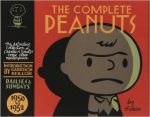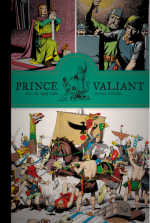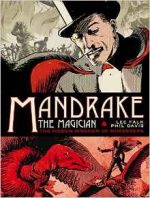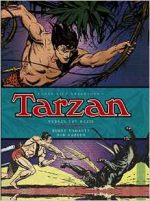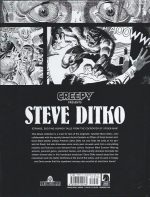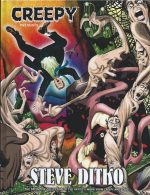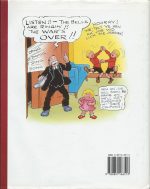
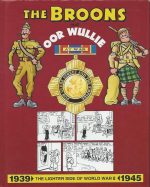
By R.D. Low & Dudley D. Watkins & various (DC Thomson)
ISBN: 978-0-85116-651-3
The Broons and Oor Wullie are, singly or in eternal conjunction, one of the longest running newspaper cartoon features in British history, having appeared continuously in Scotland’s The Sunday Post since their debut in the March 8th 1936 edition.
Both boisterous wee boy and eccentrically engaging working class clan were co-created by journalist, writer and Editor Robert Duncan Low and DC Thomson’s greatest artist Dudley D. Watkins. Once their addictively engaging strips began to be collected in reprint editions as Seasonal Annuals – with solo books or each star-feature appearing in alternate years, right up to the present day – the Broons and Oor Wullie became an international milestone, beloved by Scots far from home and all devotees of cartooning mastery.
Low (1895-1980) began at DC Thomson as a journalist, rising to the post of Managing Editor of Children’s Publication and launching, between 1921 and 1933, the company’s “Big Five†story papers for boys: Adventure, The Rover, The Wizard, The Skipper and The Hotspur.
In 1936 his next brilliant notion was the Fun Section: an 8-page comic-strip supplement to the publishing giant’s most popular national newspaper. This illustrated accessory launched on 8th March and from the outset The Broons and Oor Wullie were its standout stars…
Low’s shrewdest notion was devising both strips as domestic comedies played out in the charismatic Scottish idiom and vernacular. Supported by features such as Auchentogle by Chic Gordon, Allan Morley‘s Nero and Zero, Nosey Parker amongst others, they laid the groundwork for the company’s next great leap. In December 1937 Low launched the very first DC Thomson weekly comic. The Dandy was cautiously followed by The Beano in 1938 and an early-reading title entitled The Magic Comic a year later.
War-time paper shortages and post-war rationing strictures curtailed this budding strip periodical revolution, and it was 1953 before the next wave of groundbreaking picture paper releases. The Topper started the ball rolling again (with Oor Wullie in the logo and masthead but not part of the magazine’s regular roster) and in that same year Low and Ken Reid created Roger the Dodger for The Beano…
Low’s greatest weapon in those early days was his prolific illustrator Dudley Dexter Watkins, whose style shaped the look of DC Thompson’s comics output until the bombastic arrival of Leo Baxendale shook things up in the mid-1950s.
Watkins (1907-1969) had started life in Manchester and Nottingham as a genuine artistic prodigy before entering Glasgow College of Art in 1924. It wasn’t long before he was advised to get a job at burgeoning, Dundee-based DCT, where a 6-month trial illustrating boys’ stories led to comic strip specials and some original cartoon creations.
Percy Vere and His Trying Tricks and Wandering Willie, The Wily Explorer made him a the only choice for both lead strips in the new Fun Section and, without missing a beat, in 1937 Watkins added Dandy‘s Desperate Dan to his weekly workload and Beano‘s placidly outrageous Lord Snooty seven months later.
Watkins soldiered on in unassailable magnificence for decades, drawing some of the most lavishly lifelike and winningly hilarious strips in comics history. He died at his drawing board on August 20th 1969.
For all that time he had unflaggingly crafted a full captivating page each for Oor Wullie and The Broons every week as well as his many comics pages. His loss was a colossal blow to the company. DC Thomson reprinted old episodes of both strips in the newspaper and Annuals for seven years before a replacement was settled upon, whilst The Dandy reran Watkins’ Desperate Dan stories for twice that length of time.
A rock-solid facet of Scottish popular culture from the start, the first Broons Annual (technically Bi-Annual) had appeared in 1939, re-presenting the best of the Sunday strips; followed and replaced with Oor Wullie the next Christmas. However, as wartime paper restrictions increasingly began to bite, no annuals were published between 1943 and 1946.
Here you have a chance to scrutinise the rare strips of the war years in a sublime collection of pages tracking the cartoon icons’ experiences as typical folk getting by in the worst of all possible times…
Need a Mission Briefing?
Most of the multigenerational Brown family inhabit a tenement flat at 10 Glebe Street, in the timelessly metafictional Scottish industrial everytown of Auchentogle (sometimes alternatively dubbed Auchenshoogle and based on working-class Glasgow district of Auchenshuggle). It was and still is an ideal setting in which to tell gags, comment on events, spoof trends and fossilise the deepest and most reassuring cultural archetypes for sentimental Scots, wherever in the world they might actually be residing.
As is always the case, the adamant, unswerving keystone of any family feature is long-suffering, understanding Maw, who puts up with cantankerous, cheap, know-it-all Paw, and their battalion of stay-at-home kids – comprising in descending order of age and military preparedness – hunky, husky Joe, freakishly tall and thin Hen (Henry), sturdy Daphne, pretty Maggie, brainy Horace, mischievous twins Eck and the unnamed “ither ane†and a wee toddler referred to only as “The Bairnâ€.
Not officially billeted there but always hanging around is gruff patriarchal buffoon Granpaw – a comedic gadfly who spends more time at Glebe Street than his own cottage, constantly striving to impart decades of hard-earned if outdated experience to the kids…
Offering regular breaks from inner city turmoil and another chance to simultaneously sentimentalise, spoof and memorialise more traditional times, the family often repair to their But ‘n’ Ben (a dilapidated rustic cottage in the Highlands), always falling afoul of the weather, the countryside and all its denizens: fish, fowl, farm-grown and farm-folk…
In these wartime strips that formula was naturally disrupted as the entire family found different ways to contribute to the war-effort.
As able-bodied patriots, Joe and Hen instantly joined up but frequently found time to pop back to share tantalising tastes of the army game. Paw became an ARP (Air Raid Precautions) Warden – as did Granpaw – revealing exhausting nights on fire watch and days working at the ship yards, Maw worked with the Red Cross whilst the older girls joined the V.A.D. (Volunteer Aid Detachment). Was it merely joshing when their siblings reckoned it was just to meet more men in uniform…?
Even the fractious and boisterous young ‘uns found ways to “contributeâ€â€¦
Oor Wullie also soldiered on, giving a splendidly childlike boost to morale with his own version of “chin up and carry on, regardlessâ€. His basic set-up has always been sublimely simply and eternally evergreen: the lad is just an overly-imaginative, good-hearted scamp with a talent for finding trouble and no hope of ever avoiding parental retribution when it becomes appropriate…
Wullie – AKA William MacCallum – is an archetypal rascal with time on his hands. He can usually be found ruminatively sitting on an upturned tin bucket at the start and finish of his page-a-week exploits.
His regular cast includes Ma and Pa, local copper P.C. Murdoch, assorted embattled teachers, relatives and other interfering adults who lavish gifts or inflict opprobrium upon the little pest and his pals Fat Bob, Soapy Joe Soutar, Wee Eck et al.
During this period Wullie’s world was heavily populated with adults always ready to apply some corporal punishment and thuggish bullies equally eager to prove their physical superiority – a fact repeatedly explained away and apologised for by the embarrassed and more-evolved editors of our more civilised age…
The Lighter Side of World War II was released in 1997: part of a concerted drive to keep the earlier material available to fans. This lavish and sturdy hardback compilation (still readily available through internet vendors) offers a captivating selection of strips from April 30th 1939, with the conflict still brewing far away, and includes the entire war era before concluding in December 1945 as servicemen all over the Empire – including Hen and Joe – readied themselves for demobilisation and life on Civvie Street.
These mostly monochrome memos of mirth-under-fire begin with – and are periodically punctuated by – full-colour cover adaptations of early Annual frontispieces. In attendance are atmospheric and informative year-by-year photo-features, period editorial cartoons, fact pages and excerpted headlines from The Sunday Post and other newspapers of the time, all combining to create a chronological chronicle of the Second World War through warm, funny and indomitably defiant eyes…
The endless escapades begin in 1939 with a few pre-Hostilities traditional teasers starring Oor Wullie before The Broons kick off the “Big Show†with a strip from October 1st reflecting everyone’s sudden concern over food supplies and the draconian discipline of The Blackout. The situation soon becomes a new normal and the cartoon stars slip back into familiar gag territory enlivened by recurring themes such as Hen and Joe coming a cropper after getting the lasses to launder their uniforms…
Bonus feature ‘Oor Wullie’s War Effort’ offers a colourful perspective on the wee lad’s morale-boosting capers (with plenty of superbly cruel caricaturing of Axis leaders Hitler and Mussolini) and is followed by fact-filled asides revealing how a major publishing house accommodated the public drive to cut paper use and recycle whilst still plugging sales for Dandy, Beano and the rest…
Many Wullie strips dealt with the boisterous boy’s attempts to dodge school and join any branch of the Services who would take him, whilst, not to be outdone, Paw Broon became obsessed with spies, suspiciously bulging bags and foreign accents…
The New Year dawned with a comedy poem from the Oor Wullie 1940 Annual plus a photo-feature explaining how the conflict had progressed, after which the usual subject-matter – gleeful goofs, family frolics and slapstick tomfoolery – are augmented by gas-mask gags, bomb shelter shenanigans and childish war-games involving young and old alike, as well as strips addressing the perennial problem of how to throw parties under government restrictions. Moreover, you can’t spit (or polish) without hitting some posh officer in need of taking down a peg and all involved are constantly collecting scrap to Hurt the Hun…
A similar eccentric ode – ‘The Broons’ Hoose’ – culled from their 1941 Annual with attendant news-based picture-feature leads into that tumultuous year as an aura of artistic anarchy returned, with tales of good-natured poaching, calamitous make-do-and-mend moments, brief encounters with spivs, conmen and black marketeers as well as increased emphasis on making your own entertainment and growing your own food.
Every so often, however, the strips became a vehicle for public information as when Maw Broon uses her Co-Op “Divvy†to buy Government Savings Certificates. Every war brings out blowhards and know-it-alls, but the ones here always regret their windy pontificating whether the unwilling audiences contain Wullie or the Broon clan…
A selection of headlines, full-colour reproductions of the painted covers for 1941’s Broons and 1942’s Oor Wullie Annuals (the last ones until 1946) and the by-now traditional photo-piece precede a range of strips from the key year of the conflict, with rationing and privation now an accepted part of daily life.
It only made the strips more imaginative and funny as Watkins’s style matured into a mesmerising melding of smooth caricature with slickly realistic slapstick as morale-boosting sporting fixtures and brief forays into the countryside countered the grim or gloomy news in the rest of The Sunday Post. The year concludes with ‘At the Barber’s’: a Wullie strip from 1944 deconstructing the artist’s skill with line and form…
The 1943 photo-feature deals with good news from North Africa and Southern Italy and leads directly into yet more graphic goonery; but although specific events are never mentioned it’s clear that growing optimism is infecting all the cartoon characters. Many Wullie strips in particular could be happening before or after the conflict and no one would be any the wiser.
Men in uniform are far more common in the Broons segments, but here too they’re having fun, playing pranks and chasing lassies again…
‘Domestic Bliss’ is another deconstructed exploration of Dudley Watkins’ astounding facility with comedy staging and characterisation and precedes the 1944 photo-feature which concentrates naturally enough on D-Day.
What follows is a splendid succession of classic gag outings, with sweets back in stock, eggs aplenty, holiday outings, hospital visits and parties taking the attention away from the real world. Proper Toffs are regularly embarrassed again, officious policemen outraged and teachers are once more hard-pressed to keep control as Wullie returns to japes, misguided helpfulness and get rich-quick schemes, whilst the Glebe Street irregulars go back to teasing Daphne and Maggie over thwarted romances, finding new definitions for Paw’s cussedness, embarrassing Maw in front of guests and indulging in all sorts of uproarious bad behaviour…
After a selection of Sunday Post headlines from 1943-1945, the accompanying history photo concentrates on V.E. Day 1945 showing renewed exuberance, focusing on servicemen and loved ones coming home and funny business very much back getting back to normal.
Most individual years are especially celebrated with their specific memorable and joy-inducing Christmas/Hogmanay strips and the collection concludes with Wullie’s May 13th celebration of the European war’s ending whilst The Broons episode for December 2nd 1945 shows Joe and Hen still in uniform but unable to tell the difference between home chores when On Leave and Jankers when back in Camp…
Crammed with all-ages fun, rambunctious hilarity and comfortably domestic warmth, these inspirational examples of enviable disgrace and wit under fire celebrate a mythic lost life and time are a sure cure for post-modern glums… and you can’t say fairer than that, can you?
© D.C. Thomson & Co., Ltd. 1997.
